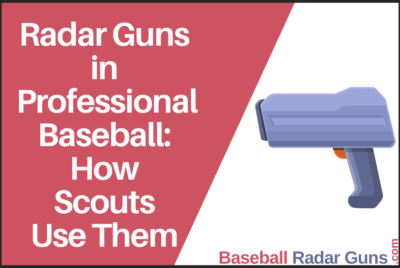When Was the First Radar Gun Used in Baseball?
*We may earn a commission for purchases made using our links. Please see our disclosure to learn more.
When Was the First Radar Gun Used in Baseball?
In the late 1970s and early 1980s, radar guns first emerged in baseball stadiums by Decatur Technologies and JUGS. These guns measured pitches significantly closer to the plate. With the help of physics, we realized that the moment a baseball left a pitcher’s hand, it would start slowing down due to drag.
Due to this, the Speedgun created by Decatur Technologies (a long-time producer of police radar guns), measured closer to the plate than JUGS, was dubbed the “slow gun,” while the JUGS gun was dubbed the “fast gun” due to more rapid readings.
Stalker then produced their Pro Sports radar gun in the early 1990s. It measured speed closer to the pitcher’s release point than the JUGS gun. The JUGS gun proceeded to be designated as the slow gun and the Stalker the “fast gun.”
An example to provide a clearer picture. A 90 mph pitch reading on the Decatur Speedgun may read as 92 mph on the JUGS gun and on a Stalker, 93-94 mph.
And with improvements in technology, the Stalker Pro II would now read that 94 mph pitch as 95 mph.
So, when you read about fastballs that hit 85-90 mph in the early 1980s, keep in mind that current measurement equipment would show them much faster. An 85 mph fastball (as measured by a Speedgun at the plate) would be roughly 93 mph if measured by the current MLB Statcast system out of the pitcher’s hand.
When was the Baseball Radar Gun Invented?
Danny Litwhiler is often cited as the creator of the baseball radar gun. His breakthrough came while visiting his oldest son, Daniel, an officer at the Air Force Academy in Colorado Springs, in the early 1970s.
He was driving on campus, and his son warned him the police employ radar. If you’re speeding, you’re going to get caught.’ When he glanced at me, I could see he had a bug in his head.”
According to his son, he said, “Let’s see if they can work on a baseball.”
When Litwhiler returned to East Lansing, he contacted a local police officer about coming to his baseball field to run an experiment. The officer drove over near the field and was instructed to point the radar gun at one of his pitchers to determine the velocity of his pitches.
The speedometer initially read 75 mph. However, the radar took the reading on a level section of the field. As a result, Litwhiler requested that the police officer drive his vehicle alongside the pitcher’s mound since the radar gun was attached to the car.
This time, the pitches registered 85 mph.
Soon after, he began working with JUGS Sports, an Oregon-based pitching machine maker, to develop a baseball-specific mechanism.
In 1974, the result was a gigantic, wired device that looked like a cross between a pistol, a bullhorn, and a blow-dryer. The portable prototype was developed in 1975 and picked up 99 out of 100 pitches.
Because Litwhiler’s idea was merely a novel application of existing technology, he was never given a patent. He did, however, get monthly royalty payments from JUGS for the rest of his life, according to his son.




